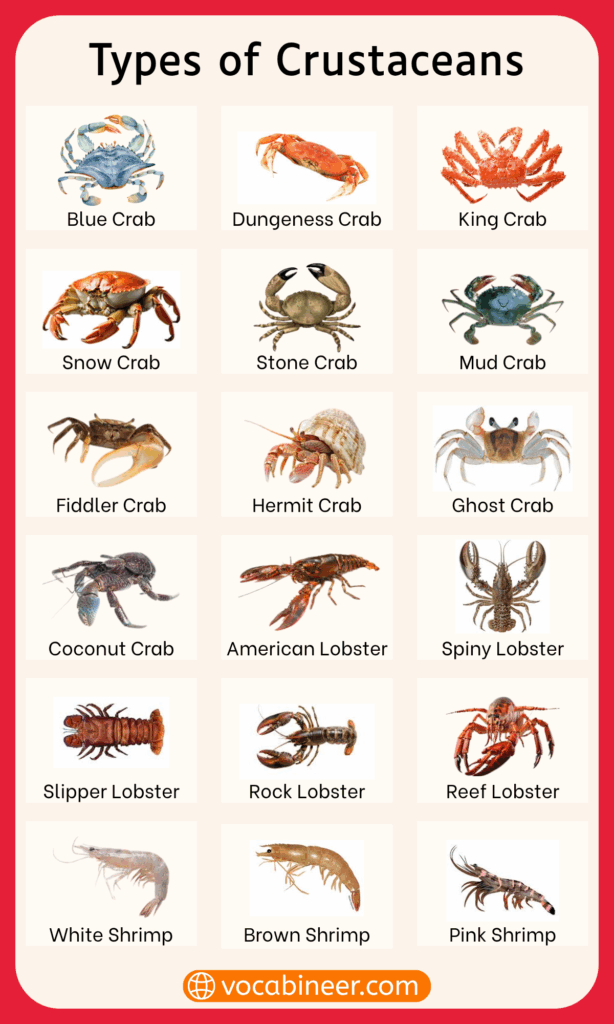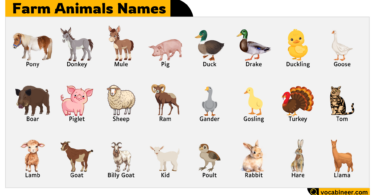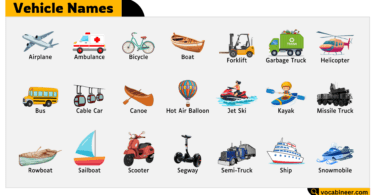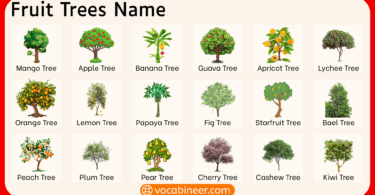Crustaceans are a large group of animals that live mostly in water and have jointed legs, hard outer shells, and many legs. These creatures come in many shapes and sizes and belong to a group called arthropods. Some swim, some crawl, and many are important in oceans, rivers, and even on dinner plates. This post introduces the types of crustaceans with their pictures. It helps recognize names used in science, cooking, fishing, and marine biology.
In This Page
Common Crustacean Types with Pictures and Names
These are the crustaceans people often see or hear about. They are easy to recognize and are part of many daily life settings like food, media, or school science lessons.
Crab
Known for its sideways walk and hard shell. Found in oceans, rivers, and even on beaches.
Lobster
Long body and big claws. Mostly found in deep sea and served as a luxury seafood.
Shrimp
Small and curved with legs underneath. Very common in cooking and found in salty and freshwater.
Prawn
Looks like a shrimp but usually larger. It is also a favorite seafood in many places.
Crayfish
Also called crawfish or crawdad. Lives in rivers and lakes and looks like a small lobster.
Krill
Tiny and shrimp-like. Found in cold ocean waters and eaten by whales and seals.
Barnacle
Sticks to rocks, ships, or whales. It has a hard outer plate and stays in one place.

Lesser-Known Crustacean Species
Some crustaceans are not common in everyday talks but are interesting and important in water systems. Learning these names helps identify strange-looking water creatures better.
Isopod
Flat body with many legs and a hard back. Some live in oceans and others in moist soil.
Amphipod
Looks like a tiny shrimp and moves fast. Lives in wet sand, lakes, or under rocks.
Mantis Shrimp
Colorful and fast-hitting. Famous for its strong punch and sharp eyes.
Copepod
Small, clear body. Found in freshwater and saltwater and forms part of the food chain.
Ostracod
Also called seed shrimp. Has a round body that looks like a small grain of rice.
Fairy Shrimp
Lives in small, seasonal ponds. Has a soft body and swims upside-down.
Tadpole Shrimp
Long tail and flat body. Found in muddy ponds or pools after rains.
Edible Crustaceans and Seafood Varieties
Crustaceans are part of many cuisines around the world. Some are caught wild, others are farmed. These names help in cooking, shopping, and restaurant orders.
Blue Crab
Popular in coastal dishes. It has a blue shell and soft meat.
King Crab
Large with long legs. Mostly caught in cold seas and served steamed or grilled.
Snow Crab
Milder taste with white meat. Used in sushi and seafood platters.
Rock Lobster
Also called spiny lobster. It has no claws and is common in tropical dishes.
Tiger Prawn
Large striped body. Often grilled, fried, or used in curries.
White Shrimp
Common in many dishes. Mild flavor and soft texture.
Langoustine
Also called Norway lobster. Smaller than a lobster but very tasty.
Microscopic and Planktonic Crustacean Animals
These crustaceans are so small they can only be seen under a microscope. They play a big role in water life and feed many ocean creatures.
Water Flea
Very small and jumps in water. Lives in ponds and is eaten by fish.
Brine Shrimp
Also known as sea monkeys. Grows in salty lakes and used as pet food.
Cyclops
Tiny and has one eye. Moves in jerks and lives in fresh water.
Calanoid Copepod
Long antennas and clear body. Lives in both seas and fresh waters.
Marine Cladocera
Tiny with round body. Floats in seas and lakes.
Land-Based and Semi-Aquatic Crustacean Species
Not all types of crustaceans stay in water. Some live on land or near water bodies. These types help understand creatures seen during walks or in gardens.
Woodlouse
Also called pill bug or roly-poly. Curves into a ball when touched and lives in soil.
Sand Hopper
Small and jumps like a flea. Lives in sandy beaches and hides under seaweed.
Land Crab
Lives mostly on land but returns to sea to breed. Has strong legs and claws.
Fiddler Crab
One small claw and one large claw. Lives in muddy shores and waves its big claw to attract mates.
Coconut Crab
World’s largest land crab. Climbs trees and breaks coconuts with strong claws.
Deep Sea Crustaceans with Unique Adaptations
Some crustaceans live in dark, deep parts of the sea. They have special features to survive without sunlight and pressure changes.
Giant Isopod
Looks like a giant version of a pill bug. Lives deep in the ocean and feeds on dead fish.
Deep Sea Amphipod
Long body and curved back. Lives below 10,000 meters in the sea.
Blind Lobster
Lives in deep water caves. Has no eyes and uses feelers to move.
Yeti Crab
Hairy claws and pale body. Lives near hot vents in deep sea floors.
Hoff Crab
Covered in fuzzy hair. Found near underwater volcanoes.
FAQs about Crustacean Types and Names
The main types of crustaceans include crabs, lobsters, shrimp, barnacles, krill, and isopods. Some live in water, while others live on land or both.
Shrimp and prawns look alike but have small body differences. Prawns are usually bigger and have straighter bodies than shrimp.
No. While many live in the sea, some crustaceans live on land like woodlice and coconut crabs. Others live in rivers, lakes, or even soil.
Common edible crustaceans include crabs, lobsters, prawns, shrimps, and langoustines. They are used in many seafood dishes around the world.
Crustaceans usually have a hard shell, jointed legs, and no backbone. If it walks sideways or has a shell and legs, it’s likely a crustacean.
Read More




